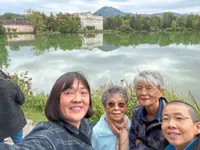The Sanjusangen-do Temple is popular with tourists. — Photos: CHIN POY SENG
People travel leisurely to a place for a variety of reasons. For me, I travelled to the Kansai area in Japan because of a short story I read some years ago.
In the story, the author said that the statues in the Sanjusangen-do Temple were so real and overwhelming that he felt like he was transported to another world. I decided to check it out myself.
Already a subscriber? Log in
Save 30% OFF The Star Digital Access
Cancel anytime. Ad-free. Unlimited access with perks.





